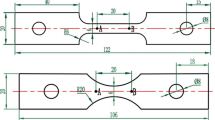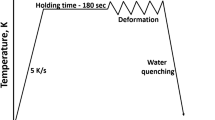Abstract
The flow behavior of Ti-6Al-4V alloy was studied by automated ball indentation (ABI) tests in a wide range of temperatures (293, 493, 693, and 873 K) and strain rates (10−6, 10−5, and 10−4 s−1). Based on the experimental true stress-plastic strain data derived from the ABI tests, the Johnson-Cook (JC), Khan-Huang-Liang (KHL) and modified Zerilli-Armstrong (ZA) constitutive models, as well as artificial neural network (ANN) methods, were employed to predict the flow behavior of Ti-6Al-4V. A comparative study was made on the reliability of the four models, and their predictability was evaluated in terms of correlation coefficient (R) and mean absolute percentage error. It is found that the flow stresses of Ti-6Al-4V alloy are more sensitive to temperature than strain rate under current experimental conditions. The predicted flow stresses obtained from JC model and KHL model show much better agreement with the experimental results than modified ZA model. Moreover, the ANN model is much more efficient and shows a higher accuracy in predicting the flow behavior of Ti-6Al-4V alloy than the constitutive equations.










Similar content being viewed by others
References
A.S. Khan and S. Yu, Deformation Induced Anisotropic Responses of Ti-6Al-4V Alloy. Part I: Experiments, Int. J. Plast., 2012, 38, p 1–13
T. Seshacharyulu, S.C. Medeiros, W.G. Frazier, and Y.V.R.K. Prasad, Hot Working of Commercial Ti-6Al-4V with an Equiaxed α-β Microstructure: Materials Modeling Considerations, Mater. Sci. Eng. A, 2000, 284, p 184–194
N. Poondla, T.S. Srivatsan, A. Patnaik, and M. Petraroli, A Study of the Microstructure and Hardness of Two Titanium Alloys: Commercially Pure and Ti-6Al-4V, J. Alloy. Compd., 2009, 486, p 162–167
J. Liu, W. Zeng, and Y. Zhu, Hot Deformation Behavior and Flow Stress Prediction of TC4-DT Alloy in Single-Phase Region and Dual-Phase Regions, J. Mater. Eng. Perform., 2015, 24, p 2140–2150
J. Luo, M. Li, X. Li, and Y. Shi, Constitutive Model for High Temperature Deformation of Titanium Alloys Using Internal State Variables, Mech. Mater., 2010, 42, p 157–165
G.R. Johnson, W.H. Cook, A Constitutive Model and Data for Metals Subjected to Large Strains, High Strain Rates and High Temperatures, Proceedings of the 7th International Symposium on Ballistics, 1983, 54, p 1–7
S. Huang and A.S. Khan, On the Use of Electrical-Resistance Metallic Foil Strain Gages for Measuring Large Dynamic Plastic Deformation, Exp. Mech., 1991, 31, p 122–125
A.S. Khan and R. Liang, Behaviors of Three BCC Metal Over a Wide Range of Strain Rates and Temperatures: Experiments and Modeling, Int. J. Plast., 1999, 15, p 1089–1109
F.J. Zerilli and R.W. Armstrong, Dislocation-Mechanics-Based Constitutive Relations for Material Dynamics Calculations, J. Appl. Phys., 1987, 61, p 1816–1825
D. Samantaray, S. Mandal, and U. Borah, A Thermo-Viscoplastic Constitutive Model to Predict Elevated-Temperature Flow Behaviour in a Titanium-Modified Austenitic Stainless Steel, Mater. Sci. Eng. A, 2009, 526, p 1–6
H. Mecking and U.F. Kocks, Kinetics of Flow and Strain-Hardening, Acta Metall., 1981, 29, p 1865–1875
P.S. Follansbee and U.F. Kocks, A Constitutive Description of the Deformation of Copper Based on the Use of the Mechanical Threshold Stress as an Internal State Variable, Acta Metall., 1988, 36, p 81–93
D.J. Bammann, Modeling Temperature and Strain Rate Dependent Large Deformation of Metals, Appl. Mech. Rev., 1990, 43, p 312–319
D.J. Bammann, M.L. Chiesa, and G.C. Johnson, Modeling Large Deformation and Failure in Manufacturing Processes, Theoretical and Applied Mechanics, T. Tatsumi, E. Wannabe, and T. Kambe, Ed., Elsevier Science, Amsterdam, 1996, p 359–376
Y.B. Guo, Q. Wen, and M.F. Horstemeyer, An Internal State Variable Plasticity-Based Approach to Determine Dynamic Loading History Effects on Material Property in Manufacturing Processes, Int. J. Mech. Sci., 2005, 47, p 1423–1441
D. Samantaray, S. Mandal, and A.K. Bhaduri, A Comparative Study on Johnson Cook, Modified Zerilli-Armstrong and Arrhenius-Type Constitutive Models to Predict Elevated Temperature Flow Behaviour in Modified 9Cr-1Mo Steel, Comput. Mater. Sci., 2009, 47, p 568–576
O. Sabokpa, A. Zarei-Hanzaki, and H.R. Abedi, Artificial Neural Network Modeling to Predict the High Temperature Flow Behavior of an AZ81 Magnesium Alloy, Mater. Des., 2012, 39, p 390–396
G. Quan, W. Lv, and Y. Mao, Prediction of Flow Stress in a Wide Temperature Range Involving Phase Transformation for As-Cast Ti-6Al-2Zr-1Mo-1V Alloy by Artificial Neural Network, Mater. Des., 2013, 50, p 51–61
N.S. Reddy, Y.H. Lee, and C.H. Park, Prediction of Flow Stress in Ti-6Al-4V Alloy with an Equiaxed α + β Microstructure by Artificial Neural Networks, Mater. Sci. Eng. A, 2008, 492, p 276–282
Y.C. Lin and X.M. Chen, A Critical Review of Experimental Results and Constitutive Descriptions for Metals and Alloys in Hot Working, Mater. Des., 2011, 32, p 1733–1759
Y. Zhu, W. Zeng, and Y. Sun, Artificial Neural Network Approach to Predict the Flow Stress in the Isothermal Compression of As-Cast TC21 Titanium Alloy, Comput. Mater. Sci., 2011, 50, p 1785–1790
W.S. Lee and C.F. Lin, High-Temperature Deformation Behavior of Ti6Al4V Alloy Evaluated by High Strain-Rate Compression Tests, J. Mater. Process. Technol., 1998, 75, p 127–136
W.S. Lee and C.F. Lin, Plastic Deformation and Fracture Behavior of Ti-6Al-4V Alloy Loaded with High Strain Rate Under Various Temperatures, Mater. Sci. Eng. A, 1998, 241, p 48–59
H.W. Meyer and D.S. Kleponis, Modeling the High Strain Rate Behavior of Titanium Undergoing Ballistic Impact and Penetration, Int. J. Impact Eng., 2001, 26, p 509–521
S. Seo, O. Min, and H. Yang, Constitutive Equation for Ti-6Al-4V at High Temperatures Measured Using the SHPB Technique, Int. J. Impact Eng., 2005, 31, p 735–754
A.S. Khan, Y.S. Suh, and R. Kazmi, Quasi-static and Dynamic Loading Responses and Constitutive Modeling of Titanium Alloys, Int. J. Plast., 2004, 20, p 2233–2248
S. Nemat-Nasser, W.G. Guo, and V.F. Nesterenko, Dynamic Response of Conventional and Hot Isostatically Pressed Ti-6Al-4V Alloys: Experiments and Modeling, Mech. Mater., 2001, 33, p 425–439
X. Shi, W. Zeng, and Y. Sun, Microstructure-Tensile Properties Correlation for the Ti-6Al-4V Titanium Alloy, J. Mater. Eng. Perform., 2015, 24, p 1754–1762
J. Xiao, D.S. Li, and X.Q. Li, Constitutive Modeling and Microstructure Change of Ti-6Al-4V During the Hot Tensile Deformation, J. Alloy. Compd., 2012, 541, p 346–352
J. Cai, F. Li, and T. Liu, Constitutive Equations for Elevated Temperature Flow Stress of Ti-6Al-4V Alloy Considering the Effect of Strain, Mater. Des., 2011, 32, p 1144–1151
J. Cai, K. Wang, and P. Zhai, A Modified Johnson-Cook Constitutive Equation to Predict Hot Deformation Behavior of Ti-6Al-4V Alloy, J. Mater. Eng. Perform., 2015, 24, p 32–44
Y. Niu, M. Li, and H. Hou, High-Temperature Deformation Behavior of Ti-6Al-4V Alloy without and with Hydrogenation Content of 0.27 wt.%, J. Mater. Eng. Perform., 2010, 19, p 59–63
A.S. Hamada, F.M. Haggag, and D.A. Porter, Non-Destructive Determination of the Yield Strength and Flow Properties of High-Manganese Twinning-Induced Plasticity Steel, Mater. Sci. Eng. A, 2012, 558, p 766–770
F. Wang, J. Zhao, and N. Zhu, A Comparative Study on Johnson-Cook Constitutive Modeling for Ti-6Al-4V Alloy Using Automated Ball Indentation (ABI) Technique, J. Alloy. Compd., 2015, 633, p 220–228
M.J. Donachie, Jr., Source Book, Titanium and Titanium Alloys, American Society for Metals, Metals Park, 1982, p 3–19
M.J. Donachie, Jr., Titanium: A Technical Guide, 2nd ed., ASTM international, Ohio, 2000
F.M. Haggag, Field Indentation Microprobe for Structural Integrity Evaluation, U.S. Patent No. 4852397, 1989
G. Das, S. Ghosh, S.C. Bose, and S. Ghosh, Use of Ball Indentation Technique to Evaluate Room Temperature Mechanical Properties of a Gas Turbine Blade, Mater. Sci. Eng. A, 2006, 424, p 326–332
G. Das, M. Das, S. Ghosh, P. Dubey, and A.K. Ray, Effect of Aging on Mechanical Properties of 6063 Al-Alloy Using Instrumented Ball Indentation Technique, Mater. Sci. Eng. A, 2010, 527, p 1590–1594
F.M. Haggag and R.K. Nanstad, Innovative Approaches to Irradiation Damage and Failure Analysis, D.L. Marriot, T.R. Mager, and W.H. Bamford, Ed., ASME, New York, 1989, p 101–109
D. Tabor, The Hardness of Metals, Clarendon Press, Oxford, 1951
F.M. Haggag, R.K. Nanstad, J.T. Hutton, D.L. Thomas, and R.L. Swain, Use of Automated Ball Indentation Testing to Measure Flow Properties and Estimate Fracture Toughness in Metallic Materials, ASTM STP, 1990, 1092, p 188–208
T. Özel and E. Zeren, Determination of Work Material Flow Stress and Friction for FEA of Machining Using Orthogonal Cutting Tests, J. Mater. Process. Technol., 2004, 153, p 1019–1025
N. Kotkunde, A.D. Deole, and A.K. Gupta, Comparative Study of Constitutive Modeling for Ti-6Al-4V Alloy at Low Strain Rates and Elevated Temperatures, Mater. Des., 2014, 55, p 999–1005
J. Liu, H. Chang, and T.Y. Hsu, Prediction of the Flow Stress of High-Speed Steel During Hot Deformation Using a BP Artificial Neural Network, J. Mater. Process. Technol., 2000, 103, p 200–205
Y.C. Lin, J. Zhang, and J. Zhong, Application of Neural Networks to Predict the Elevated Temperature Flow Behavior of a Low Alloy Steel, Comput. Mater. Sci., 2008, 43, p 752–758
Acknowledgments
This work is sponsored by the National Natural Science Foundation of China (51175310).
Author information
Authors and Affiliations
Corresponding author
Rights and permissions
About this article
Cite this article
Wang, F., Zhao, J. & Zhu, N. Constitutive Equations and ANN Approach to Predict the Flow Stress of Ti-6Al-4V Alloy Based on ABI Tests. J. of Materi Eng and Perform 25, 4875–4884 (2016). https://doi.org/10.1007/s11665-016-2337-4
Received:
Revised:
Published:
Issue Date:
DOI: https://doi.org/10.1007/s11665-016-2337-4




